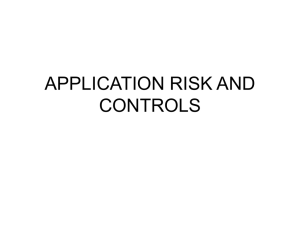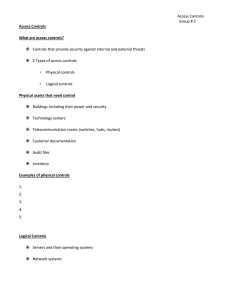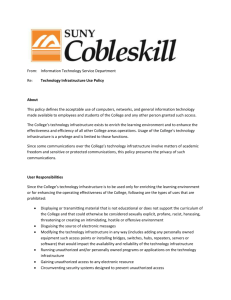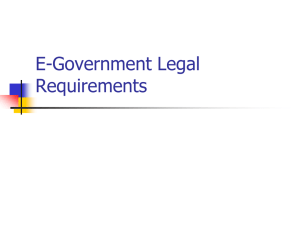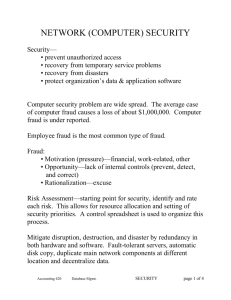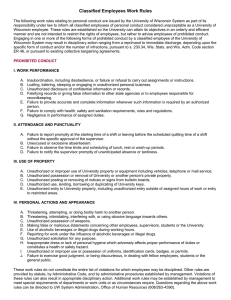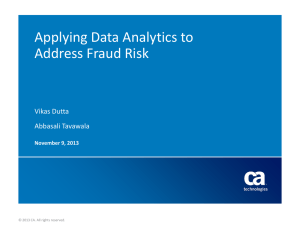Fraud Word Game
advertisement
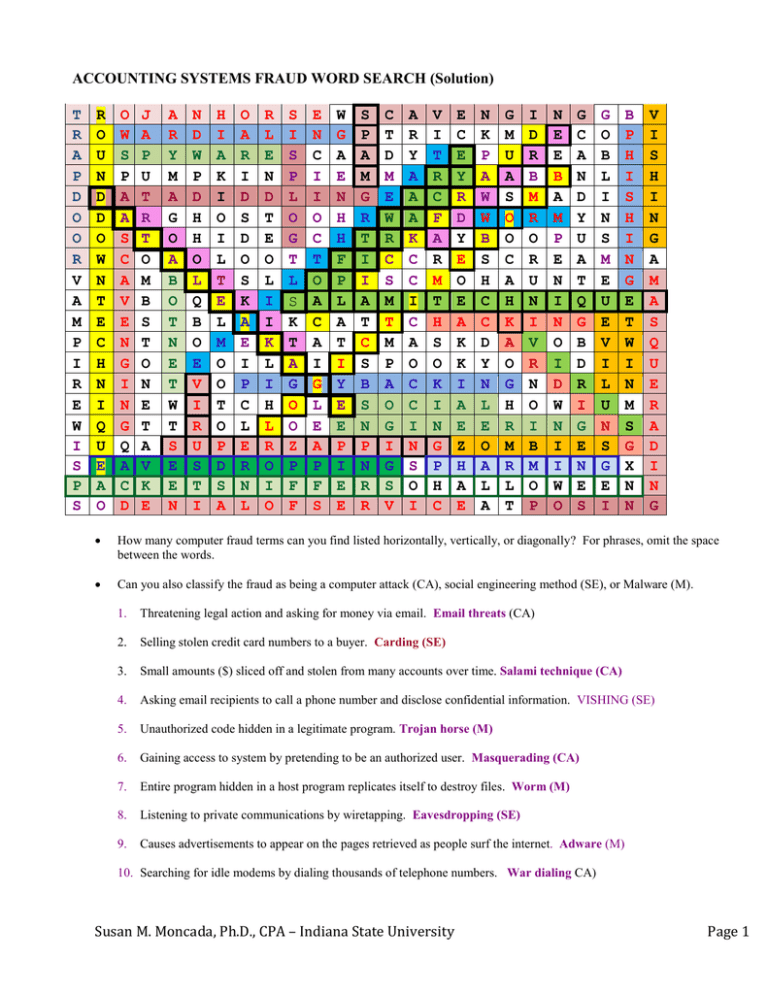
ACCOUNTING SYSTEMS FRAUD WORD SEARCH (Solution) T R A P D O O R V A M P I R E W I S P S R O U N D D O W N T E C H N I Q U E A O O W S P A A S C A V E N G I N G Q A C D J A P U T R T O M B S T O N E T A V K E A R Y M A G O A B O T N E T W T S E E N N D W P D H H O L Q B O E V I R U S T I H I A K I O I L T E L M O O T O P D S A O A R I D S D O S K A E I P C L E R N L R L E N D T E O L I I K L I H L R O I O S I S P L O G T L S K T A G O O Z P F F E N C I I O C T O A C A I G L E A P F S W G A E N H H F P L A T I Y E E P I E E S P A M G R T I I A T C S B S N P N R R C T D M E W R C S M T M P A O G I G S V A R Y A A A K C C I C A O C C I N S O I V I T R C F A R M T H S O K I N G P H C E C E Y R D Y E O E A K K I A E Z H A E N K P A W W B S H C C D Y N L E O A L A G M U A S O O C A H K A O G H R M R L T I D R B M R O R U N I V R N O I B M O P N E E B A M P E N I N O I D W N I I W O G C A N D Y U A T Q G B D R I G E N E S G O B L I N S M E U E V I L U N S G E I B P H I S H I N G E T W I N M S G X N N V I S H I N G A M A S Q U E R A D I N G How many computer fraud terms can you find listed horizontally, vertically, or diagonally? For phrases, omit the space between the words. Can you also classify the fraud as being a computer attack (CA), social engineering method (SE), or Malware (M). 1. Threatening legal action and asking for money via email. Email threats (CA) 2. Selling stolen credit card numbers to a buyer. Carding (SE) 3. Small amounts ($) sliced off and stolen from many accounts over time. Salami technique (CA) 4. Asking email recipients to call a phone number and disclose confidential information. VISHING (SE) 5. Unauthorized code hidden in a legitimate program. Trojan horse (M) 6. Gaining access to system by pretending to be an authorized user. Masquerading (CA) 7. Entire program hidden in a host program replicates itself to destroy files. Worm (M) 8. Listening to private communications by wiretapping. Eavesdropping (SE) 9. Causes advertisements to appear on the pages retrieved as people surf the internet. Adware (M) 10. Searching for idle modems by dialing thousands of telephone numbers. War dialing CA) Susan M. Moncada, Ph.D., CPA – Indiana State University Page 1 11. Programs that gather data from information packets as they traverse the Internet. Packet sniffers (M) 12. Using someone’s WIFI by latching onto the data communication of a legitimate user. Piggybacking (CA) 13. Changing data in an unauthorized way. Data Diddling (CA) 14. Permits bypass of normal system controls to allow a way into a program or system. Trap Door (M) 15. Creating a bogus Internet business that seems legitimate to make sales to customers but never deliver the product. Posing (SE) 16. Use of special program to bypass regular controls. Superzapping (M) 17. Unauthorized copying of data files. Data Leakage (CA) 18. Fraudulent emails sent asking recipients to verify banking information. Phishing (SE) 19. Clicking online advertisements repeatedly to inflate advertising revenues. Click Fraud (CA) 20. Depositing fractions from an interest calculation into a programmers account. Round-down technique (CA) 21. Segment of executable code that attaches to software, is intended to replicate and do damage to several computer systems. Virus (M) 22. Tricking an employee into providing information to access a system. Social engineering 23. Unauthorized copying of software. Software piracy (CA) 24. Gaining access to a computer system by searching through someone’s trash. Scavenging (SE) 25. Sending hundreds of e-mail messages to shut down a Web site. Denial of service (CA) 26. Program that lies idle until a circumstance triggers it. Once triggered the program sabotages the system by destroying programs and data. Logic time bomb (M) 27. Redirecting users to a website that appears to be legitimate in order to gain access to confidential information. PHARMING (SE) 28. A program that hides files, etc. from the operating system. Rootkit (M) 29. A network of hijacked computers used in a denial-of-service attack or to spread email spam. Botnet (CA) 30. An email message sent to thousands of people through the Internet. Spam (CA) 31. Unauthorized access and use of a computer system. Hacking (CA) 32. A blog that promotes web sites to increase their Google page rank. SPLOG (CA) 33. Software that tracks the computing habits of a user and sends it to someone else without the user’s knowledge or permission. Spyware (M) 34. The name for the individual hijacked computers that could be used to unleash a spam attack. Zombies (CA) 35. A wireless network that has the same Service Set Identifier (SSID) as the access point for a company’s wireless network. Evil Twin (SE) Susan M. Moncada, Ph.D., CPA – Indiana State University Page 2
